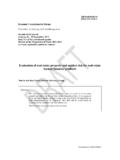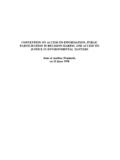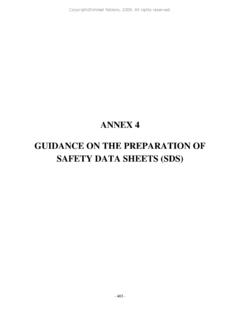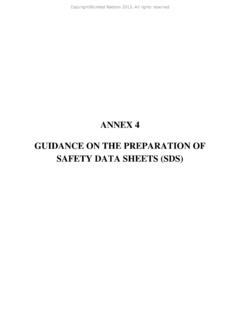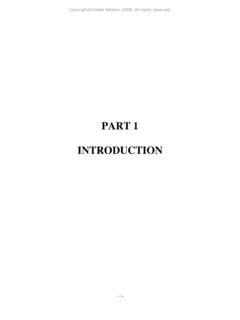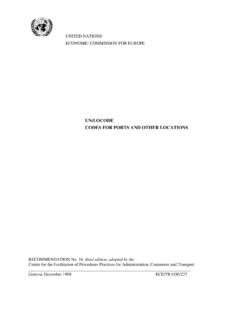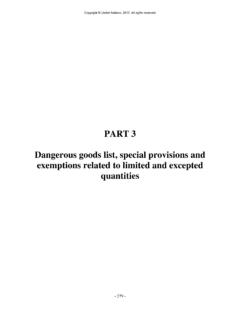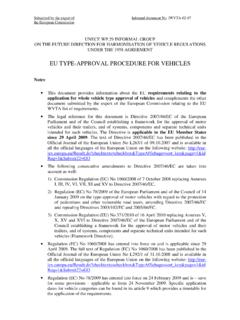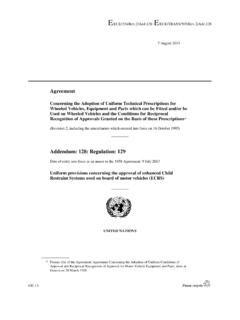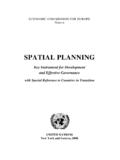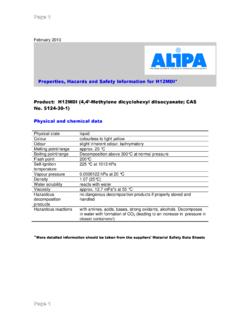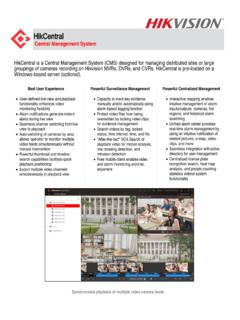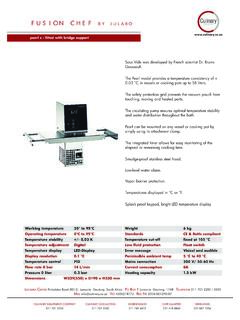Transcription of ANNEX 3 CODIFICATION OF HAZARD STATEMENTS, …
1 ANNEX 3 CODIFICATION OF HAZARD STATEMENTS, CODIFICATION AND USE OF PRECAUTIONARY STATEMENTS, CODIFICATION OF HAZARD PICTOGRAMS AND EXAMPLES OF PRECAUTIONARY PICTOGRAMS Copyright@United Nations 2013. All rights reserved Copyright@United Nations 2013. All rights reserved - 269 - ANNEX 3 Section 1 CODIFICATION OF HAZARD STATEMENTS Introduction HAZARD statement means a statement assigned to a HAZARD class and category that describes the nature of the hazards of a hazardous product, including, where appropriate, the degree of HAZARD . This section contains the recommended codes assigned to each of the HAZARD statements applicable to the HAZARD categories under the GHS. The HAZARD statement codes are intended to be used for reference purposes.
2 They are not part of the HAZARD statement text and should not be used to replace it. CODIFICATION of HAZARD statements HAZARD statements are assigned a unique alphanumerical code which consists of one letter and three numbers, as follows: (a) the letter H (for HAZARD statement ); (b) a number designating the type of HAZARD to which the HAZARD statement is assigned according to the numbering of the different parts of the GHS, as follows: 2 for physical hazards ; 3 for health hazards ; 4 for environmental hazards ; (c) two numbers corresponding to the sequential numbering of hazards arising from the intrinsic properties of the substance or mixture, such as explosivity (codes from 200 to 210), flammability (codes from 220 to 230), etc.
3 The codes to be used for designating HAZARD statements are listed, in numerical order, in Table for physical hazards , Table for health hazards and Table for environmental hazards . Each table is divided into 4 columns containing the following information: Column (1) The HAZARD statement code; Column (2) The HAZARD statement text; The text in bold should appear on the label, except as otherwise specified. The information in italics should also appear as part of the HAZARD statement when the information is known. For example: causes damages to organs (or state all organs affected, if known) through prolonged or repeated exposure (state route of exposure if it is conclusively proven that no other routes of exposure cause the HAZARD ).
4 Column (3) HAZARD class, with a reference to the chapter of the GHS where information about the HAZARD class may be found. Column (4) The HAZARD category or categories within a HAZARD class for which the use of a HAZARD statement is applicable. Copyright@United Nations 2013. All rights reserved - 270 - In addition to individual HAZARD statements, a number of combined HAZARD statements are given in Table The alphanumerical codes for the combined statements are constructed from the codes for the individual statements that are combined, conjoined with the plus ( + ) sign. For example, H300 + H310 indicates that the text to appear on the label is Fatal if swallowed or in contact with skin.
5 All assigned HAZARD statements should appear on the label unless otherwise specified in The competent authority may specify the order in which they appear. Also, where a combined HAZARD statement is indicated for two or more HAZARD statements, the competent authority may specify whether the combined HAZARD statement or the corresponding individual statements should appear on the label, or may leave the choice to the manufacturer/supplier. Table : HAZARD statement codes for physical hazards Code Physical HAZARD statements HAZARD class (GHS chapter) HAZARD category (1) (2) (3) (4) H200 Unstable explosive Explosives (chapter ) Unstable explosive H201 Explosive; mass explosion HAZARD Explosives (chapter ) Division H202 Explosive; severe projection HAZARD Explosives (chapter ) Division H203 Explosive.
6 Fire, blast or projection HAZARD Explosives (chapter ) Division H204 Fire or projection HAZARD Explosives (chapter ) Division H205 May mass explode in fire Explosives (chapter ) Division H220 Extremely flammable gas Flammable gases (chapter ) 1 H221 Flammable gas Flammable gases (chapter ) 2 H222 Extremely flammable aerosol Aerosols (chapter ) 1 H223 Flammable aerosol Aerosols (chapter ) 2 H224 Extremely flammable liquid and vapour Flammable liquids (chapter ) 1 H225 Highly flammable liquid and vapour Flammable liquids (chapter ) 2 H226 Flammable liquid and vapour Flammable liquids (chapter ) 3 H227 Combustible liquid Flammable liquids (chapter ) 4 H228 Flammable solid Flammable solids (chapter ) 1, 2 H229 Pressurized container: may burst if heated Aerosols (chapter ) 1, 2, 3 H230 May react explosively even in the absence of air Flammable gases (including chemically unstable gases) (chapter ) A (Chemically unstable gases) H231 May react explosively even in the absence of air at elevated pressure and/or temperature Flammable gases (including chemically unstable gases) (chapter ) B (Chemically unstable gases) H240 Heating may cause an explosion Self-reactive substances and mixtures (chapter ); and Organic peroxides (chapter ) Type A H241 Heating may cause a fire or explosion Self-reactive substances and mixtures (chapter ).
7 And Organic peroxides (chapter ) Type B H242 Heating may cause a fire Self-reactive substances and mixtures (chapter ); and Organic peroxides (chapter ) Types C, D, E, F Copyright@United Nations 2013. All rights reserved - 271 - Code Physical HAZARD statements HAZARD class (GHS chapter) HAZARD category (1) (2) (3) (4) H250 Catches fire spontaneously if exposed to air Pyrophoric liquids (chapter ); Pyrophoric solids (chapter ) 1 H251 Self-heating; may catch fire Self-heating substances and mixtures (chapter ) 1 H252 Self-heating in large quantities; may catch fire Self-heating substances and mixtures (chapter ) 2 H260 In contact with water releases flammable gases which may ignite spontaneously Substances and mixtures which, in contact with water, emit flammable gases (chapter ) 1 H261 In contact with water releases flammable gas Substances and mixtures which, in contact with water, emit flammable gases (chapter ) 2, 3 H270 May cause or intensify fire; oxidizer Oxidizing gases (chapter ) 1 H271 May cause fire or explosion; strong oxidizer Oxidizing liquids (chapter ); Oxidizing solids (chapter ) 1 H272 May intensify fire; oxidizer Oxidizing liquids (chapter ); Oxidizing solids (chapter ) 2, 3 H280 Contains gas under pressure.
8 May explode if heated Gases under pressure (chapter ) Compressed gas Liquefied gas Dissolved gas H281 Contains refrigerated gas; may cause cryogenic burns or injury Gases under pressure (chapter ) Refrigerated liquefied gas H290 May be corrosive to metals Corrosive to metals (chapter ) 1 Copyright@United Nations 2013. All rights reserved - 272 - Table : HAZARD statement codes for health hazards Code Health HAZARD statements HAZARD class (GHS chapter) HAZARD category (1) (2) (3) (4) H300 Fatal if swallowed Acute toxicity, oral (chapter ) 1, 2 H301 Toxic if swallowed Acute toxicity, oral (chapter ) 3 H302 Harmful if swallowed Acute toxicity, oral (chapter ) 4 H303 May be harmful if swallowed Acute toxicity, oral (chapter ) 5 H304 May be fatal if swallowed and enters airways Aspiration HAZARD (chapter ) 1 H305 May be harmful if swallowed and enters airways Aspiration HAZARD (chapter ) 2 H310 Fatal in contact with skin Acute toxicity, dermal (chapter ) 1, 2 H311 Toxic in contact with skin Acute toxicity, dermal (chapter )
9 3 H312 Harmful in contact with skin Acute toxicity, dermal (chapter ) 4 H313 May be harmful in contact with skin Acute toxicity, dermal (chapter ) 5 H314 Causes severe skin burns and eye damage Skin corrosion/irritation (chapter ) 1A, 1B, 1C H315 Causes skin irritation Skin corrosion/irritation (chapter ) 2 H316 Causes mild skin irritation Skin corrosion/irritation (chapter ) 3 H317 May cause an allergic skin reaction Sensitisation, skin (chapter ) 1, 1A, 1B H318 Causes serious eye damage Serious eye damage/eye irritation (chapter ) 1 H319 Causes serious eye irritation Serious eye damage/eye irritation (chapter ) 2A H320 Causes eye irritation Serious eye damage/eye irritation (chapter ) 2B H330 Fatal if inhaled Acute toxicity, inhalation (chapter ) 1, 2 H331 Toxic if inhaled Acute toxicity, inhalation (chapter ) 3 H332 Harmful if inhaled Acute toxicity, inhalation (chapter ) 4 H333 May be harmful if inhaled Acute toxicity, inhalation (chapter ) 5 H334 May cause allergy or asthma symptoms or breathing difficulties if inhaled Sensitisation, respiratory (chapter ) 1, 1A, 1B H335 May cause respiratory irritation Specific target organ toxicity, single exposure; Respiratory tract irritation (chapter ); 3 H336 May cause drowsiness or dizziness Specific target organ toxicity, single exposure.
10 Narcotic effects (chapter ) 3 H340 May cause genetic defects (state route of exposure if it is conclusively proven that no other routes of exposure cause the HAZARD ) Germ cell mutagenicity (chapter ) 1A, 1B H341 Suspected of causing genetic defects (state route of exposure if it is conclusively proven that no other routes of exposure cause the HAZARD ) Germ cell mutagenicity (chapter ) 2 H350 May cause cancer (state route of exposure if it is conclusively proven that no other routes of exposure cause the HAZARD ) Carcinogenicity (chapter ) 1A, 1B Copyright@United Nations 2013. All rights reserved - 273 - Code Health HAZARD statements HAZARD class (GHS chapter) HAZARD category (1) (2) (3) (4) H351 Suspected of causing cancer (state route of exposure if it is conclusively proven that no other routes of exposure cause the HAZARD ) Carcinogenicity (chapter ) 2 H360 May damage fertility or the unborn child (state specific effect if known)(state route of exposure if it is conclusively proven that no other routes of exposure cause the HAZARD ) Reproductive toxicity (chapter ) 1A, 1B H361 Suspected of damaging fertility or the unborn child (state specific effect if known)(state route of exposure if it is conclusively proven that no other routes of exposure cause the HAZARD )
